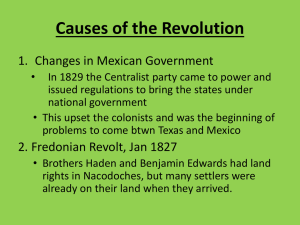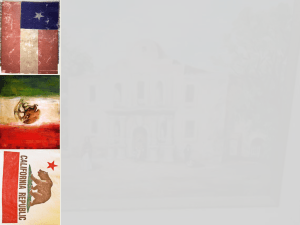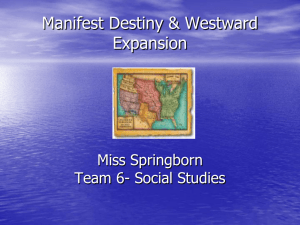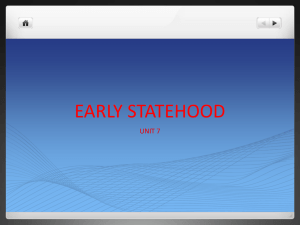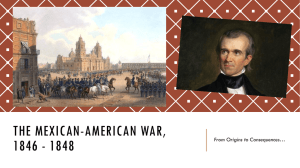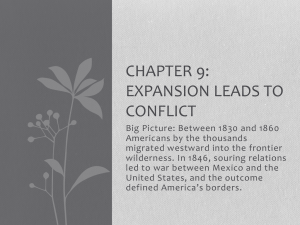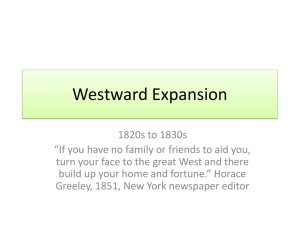Lecture 14, Territorial Expansion
advertisement
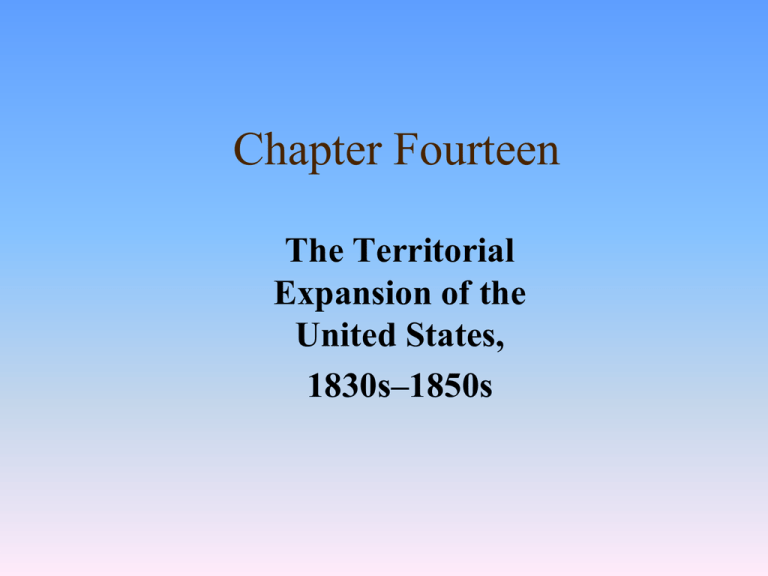
Chapter Fourteen The Territorial Expansion of the United States, 1830s–1850s Santa Fe trail The Santa Fe Trail was a 19thcentury transportation route through central North America that connected Missouri with Santa Fe, New Mexico Manifest destiny Manifest Destiny was the 19th century American belief that the United States was destined to expand across the continent. Oregon trail The Oregon Trail is a 2,000-mile (3,200 km) historic east-west wagon route that connected the Missouri River to valleys in Oregon and locations in between. Tejanos Term used to identify a Texan of Mexican descent. Empresarios An empresario was a person who, in the early years of the settlement of Texas, had been granted the right to settle on Mexican land in exchange for recruiting and taking responsibility for new settlers. The word is Spanish for entrepreneur Alamo A 13-day siege, Mexican troops under President General Antonio López de Santa Anna launched an assault on the Alamo Mission near San Antonio de Béxar (modern-day San Antonio, Texas). Californios Spanish-speaking Catholic people, regardless of race, born in California before 1848 Wilmot proviso Wilmot Proviso, one of the major events leading to the Civil War, would have banned slavery in any territory to be acquired from Mexico in the Mexican War or in the future. Popular sovereignty Popular sovereignty or the sovereignty of the people is the political principle that the legitimacy of the state is created and sustained by the will or consent of its people What role did the federal government play in the exploration o the west? What role did the federal government play in the exploration o the west? What were the important consequences of the Mexican- American War? What kinds of people participated in the California Gold Rush? What kinds of people participated in the California Gold Rush? What key factors explain the outcome of the election of 1848? What key factors explain the outcome of the election of 1848? Chapter Focus Questions How did the political effects of expansion heighten sectional tensions? How did the concept of manifest destiny affect continental expansion? How was the frontier development in Oregon, Texas, and California similar and different? Texans and Tejanos “Remember the Alamo!” Remember the Alamo The Texas uprising: alliance between Americans and Tejanos. The Tejano elite welcomed American entrepreneurs The Mexican state was unstable The so-called “Second Battle of the Alamo” occurred when these two genteel antagonists, Adina De Zavala, on the left, and Clara Driscoll on the right, disagreed over whether to include the site’s Spanish and Mexican history (De Zavala) or whether, as Driscoll wished, to focus only on the Anglo heroes of the 1836 defeat. Driscoll won. Clara Driscoll.Gift of Mrs.L.T.Barrow,1978.Daughters of the Republic of Texas Library,CN96.2. This modern photograph of the Alamo chapel by the well-known landscape photographer David Muench conveys the pristine and rather nostalgic atmosphere of the site that describes itself as “the Cradle of Texas liberty.” SOURCE:© David Muench//CORBIS. This sculpture is part of the Alamo Cenotaph, a memorial to the slain defenders of the Alamo that was erected in Alamo Plaza in 1940. The two prominent figures are the famous defenders William B. Travis (in uniform) and Davy Crockett. ©Lee Snider/Corbis. Because Tejano leader Juan Seguin escaped from the Alamo to rally reinforcements, he survived the battle, only to live to see the heroism of Anglo leaders commemorated in memorials like the Cenotaph, but not the Tejanos who died with them. Texas State Preservation Board. Commissioned by a Dallas businessman in 1903, this famous painting hangs in the Texas governor’s mansion in Austin. In this imaginary rendition of the battle, the omission of Tejano defenders from the scene allowed the artist to use light and dark to sharpen the contrast between the good Anglos and the bad Mexicans. Robert Jenkins Onderdonk,The Fall of the Alamo.Friends of the Governor ’s Mansion,Austin. Remember the Alamo Tejanos played key roles in the Texas Revolution, Frontier pattern of dealing with native people was by: first, blending with them second, occupying the land third, excluding or removing native settlers. Part Three: Exploring the West The Fur Trade Fur trade was greatest spur to exploration American companies challenged British in 1820s. Trappers known as mountain men: accommodated themselves Indians rarely came in contact with whites viewed as the advance guard of the market revolution. By 1840s the beaver was virtually trapped out. The artist Alfred Jacob Miller, a careful observer of the western fur trade, shows a mountain man and his Indian wife in his 1837 Bourgeois Walker & His Wife. Walker and his wife worked together to trap and prepare beaver pelts for market, as did other European men and their Indian wives. SOURCE:The Walters Art Museum,Baltimore (37.1940.78). Government-Sponsored Exploration The federal government promoted western expansion MAP 14.1 Exploration of the Continent, 1804–30 Lewis and Clark’s “voyage of discovery” of 1804–06 was the first of many government-sponsored western military expeditions. Crossing the Great Plains in 1806, Lieutenant Zebulon Pike was captured by the Spanish in their territory and taken to Mexico, but returned in 1807 via Texas. Major Stephen Long, who crossed the Plains in 1819–20, found them “arid and forbidding.” Meanwhile, fur trappers, among them the much-traveled Jedediah Smith, became well acquainted with the West as they hunted beaver for their pelts. Expansion and Indian Policy Government looked to West as refuge for eastern Indians. Encroachment on new Indian Territory rapid. The government pushed for further land concessions. Major battles between whites and Indians occurred after the Civil War. MAP 14.2 Indian Territory Before the Kansas-Nebraska Act of 1854 Indian Territory lay west of Arkansas, Missouri, and lowa and east of Spanish Territory. Most of the Indian peoples who lived there in the 1830s and the 1840s had been “removed” from east of the Mississipi River. The southern part (now Oklahoma) was inhabited by peoples from the Old Southwest: the Cherokees, Chickasaws, Choctaws, Creeks, and Seminoles. North of that (in what is now Kansas and Nebraska) lived peoples who had been removed from the Old Northwest. All these Indian peoples had trouble adjusting not only to a new climate and a new way of life, but to the close proximity of some Indian tribes who were their traditional enemies. Alfred Jabob Miller painted the busy life of Fort Laramie, a multiracial trading fort, in 1837. Bent’s Fort, another multiracial trading center, would have looked much like this. SOURCE:The Interior of Fort Laramie , 1858 –1860.The Walters Art Museum,Baltimore (37.1940.1). Part Four: The Politics of Expansion Manifest Destiny, an Expansionist Ideology Journalist John O’Sullivan coined the phrase “manifest destiny”. Westward expansion would increase trade and enable whites to “civilize” Indians. Democrats saw expansion as the cure for national ills. Whigs feared expansion would bring up the slavery issue. The Overland Trails Map: The Overland Trails, 1840, p. 397 The great trails started at the Missouri River. The Oregon, California, and Mormon Trails followed the Platte River into Wyoming. The Santa Fe Trail was much harsher. The 2,000-mile Overland Trail was a long, expensive, and hazardous journey. MAP 14.3 The Overland Trails, 1840 All the great trails west started at the Missouri River. The Oregon, California, and Mormon Trails followed the Platte River into Wyoming, crossed South Pass, and divided in western Wyoming. The much harsher Santa Fé Trail stretched 900 miles southwest across the Great Plains. All of the trails crossed Indian Territory and, to greater or lesser extent, Mexican possessions as well. The Overland Trails Pioneers traveled in groups, often hired a pilot. Men were responsible for care of the animals. Women prepared food and took care of the children. Problem arose when the parties reached Rockies. Disease plagued the pioneers. Oregon After 1818, the United States and Britain jointly controlled Oregon territory. Along with fur trappers, missionaries were among the earliest white settlers. Conflicts with Indians resulted in periodic bloodbaths. Disease greatly reduced the Indian population. By the mid-1840s “Oregon Fever” broke out. “Overland Emigration to Oregon, California, and Utah” FIGURE 14.1 Overland Emigration to Oregon, California, and Utah, 1840–60 Before 1849, the westward migration consisted primarily of family groups going to Oregon or Utah. The discovery of gold in California dramatically changed the migration: through 1854, most migrants were single men “rushing” to California, which remained the favored destination up until 1860. Over the twenty-year period from 1840 to 1860, the Overland Trails were transformed from difficult and dangerous routes to well-marked and well-served thoroughfares. SOURCE:John Unruh Jr.,The Plains Across (Champaign-Urbana: University of Illinois Press,1979),pp.119 –20 Oregon: Settlements White Oregonians built closely-knit communities. African Americans were formally excluded. Relations with the Indians were peaceful until 1847 The Santa Fe Trade New Mexico welcomed American trade along Santa Fe Trail. American trappers and traders assimilated with locals. The trail was hard, arduous, and dangerous. High profits. Texas from Mexican Province to State Maps: Texas MAP 14.4a Texas: From Mexican Province to U.S. State In the space of twenty years, Texas changed shape three times. Initially part of the Mexican province of Coahuila y Tejas, it became the Republic of Texas in 1836, following the Texas Revolt, and was annexed to the United States in that form in 1845. Finally, in the Compromise of 1850 following the Mexican-American War, it took its present shape. MAP 14.4b Texas: From Mexican Province to U.S. State MAP 14.4c Texas: From Mexican Province to U.S. State Mexican Texas In Texas, multiethnic settlements revolved around the presidio, mission, and rancho. Mexican authorities sought American settlement. Americans provided buffer between its heartland and Comanches. Mexican Texas Stephen F. Austin promoted American emigration. Generally, slaveholders came to grow cotton. Americans viewed Texas as an extension of Mississippi and Louisiana. Toward Texas Independence Texas cultures: Mexicans maintained ranches and missions in the South. Americans farmed the eastern and south central sections. The Comanches held their hunting grounds on the frontier. Painted by George Catlin about 1834, this scene, Commanche Village Life, shows how the everday life of the Comanches was tied to buffalo. The women in the foreground are scraping buffalo hide, and buffalo meat can be seen drying on racks. The men and boys may be planning their next buffato hunt. SOURCE:Art Resource,N.Y. Toward Texas Independence In 1828, a new Mexican government sought to control Texas by restricting immigration outlawing slavery and raising taxes. Americans saw their own culture as superior to “mongrel Spanish-Indian(s).” The Texas Revolt War broke out in 1835. The Mexican army overwhelmed Americans at the Alamo. At the San Jacinto River, Sam Houston’s forces won. Treaty granted independence to the Republic of Texas Southern boundary at the Rio Grande. Texas and the Election of 1844 The Texas Republic developed after US rejected admission Fear of rekindling slave state/free state conflicts. Within the Texas, conflicts between Anglos and Tejanos grew President Tyler raised the issue of annexation in 1844 with hopes of re-election Texas and the Election of 1844 Polk won the 1844 election. Polk called for “the re-occupation of Oregon and the re-annexation of Texas…” 1844 election interpreted as a mandate for expansion. Texas became a state in 1845. Part Five: The Mexican-American War Origins of the War Polk was committed to expanding U.S. territory. He peacefully settled the Oregon controversy. Increasing tensions with Mexico; broken relations. Polk wanted to extend U.S. territory to the Pacific. Polk encouraged a takeover of California. A border dispute led Polk to order troops to Mexico. Mr. Polk’s War The dispute with Mexico erupted into war when: Mexico refused to receive Polk’s envoy brief skirmish occurred on the Texas-Mexico border. Polk asked for war with Mexico. Mr. Polk’s War The call to war was politically divisive. Mass and individual protests occurred. The Mexican-American War Maps: The Mexican-American War, 1846– 1848 Polk planned the war strategy He sent troops into the northern provinces of Mexico New Mexico and California were conquered. MAP 14.5 The Mexican-American War 1846–1848 The Mexican-American War began with an advance by U.S. forces into the disputed area between the Nueces River and the Rio Grande in Texas. The war’s major battles were fought by General Zachary Taylor in northern Mexico and General Winfield Scott in Vera Cruz and Mexico City. Meanwhile Colonel Stephen Kearny secured New Mexico and, with the help of the U.S. Navy and John C. Frémont’s troops, California. The Invasion of Mexico Victories in Mexico came hard. Fierce Mexican resistance. American committed brutalities against Mexican citizens. When General Scott captured Mexico City, the war ended. General Winfield Scott is shown at moment of victory, riding into Mexico City’s central square in 1847 to accept the Mexican surrender. Triumphant lithographs like this were very popular with the American public, who knew very little about the hardship and brutality of the sixmonth long campaign that preceded it. SOURCE:Carl Nebel,Lithegraph 1847.Special Collection University of Texas,Arlington. American Expansion after the MexicanAmerican War Polk had ambitions of taking over Mexico Strong opposition made him accept Treaty of Guadalupe Hidalgo. Territory Added, 1845–1853 MAP 14.6 Territory Added, 1845– 53 James K. Polk was elected president in 1844 on an expansionist platform. He lived up to most of his campaign rhetoric by gaining the Oregon Country (to the forty-ninth parallel) peacefully from the British, Texas by the presidential action of his predecessor John Tyler, and present-day California, Arizona, Nevada, Utah, New Mexico, and part of Colorado by war with Mexico. In the short space of three years, the size of the United States grew by 70 percent. In 1853, the Gadsden Purchase added another 30,000 square miles. The unprecedented immediacy of the news reporting of the Mexican-American War, transmitted for the first time by telegraph, is captured here by Richard Caton Woodville in War News from Mexico (1848). By including an African American man and child, the artist is also voicing a political concern about the effect of the war on slavery. SOURCE:Richard Caton Woodville,War News from Mexico,oil on canvas. Manovgian Foundation,on loan to the National Gallery of Art, Washington,DC. The Press and Popular War Enthusiasm Mexican-American War was first conflict featuring on-the-scene reporting. Reports united Americans in temporary, emotional community. Heroes like Taylor and Scott became presidential candidates. Part Six: California and the Gold Rush J. Goldsborough Bruff, one of thousands who rushed to California for gold in 1849, sketched many events in his Overland Trail journey. Here he depicts several wagons being ferried over the Platte River. The need for individuals to cooperate is obvious. Less obvious in this sketch is the danger: most river crossing points lacked ferries, and both people and livestock often drowned trying to ford them. SOURCE:Joseph Goldsborough Bruff,Ferriage of the Platte above the Mount of Deer Creek,July 20,1849.The Henry E.Huntington Library and Art Gallery,San Marino,CA (HM 8044,#50). California Before the Gold Rush The Russians had enjoyed a brisk trade in California. John Sutter, helped Americans emigrate to California. An American community grew up around Sutter’s land grant, Gold! Map: California in the Gold Rush Discovery of gold in 1848 triggered a massive gold rush: white Americans Mexicans Chinese. Because it was the entry port and supply point, San Francisco grew from a village of 1,000 in 1848 to a city of 35,000 in 1850. MAP 14.7 California in the Gold Rush This map shows the major gold camps along the Mother Lode in the western foothills of the Sierra Nevada mountains. Gold seekers reached the camps by crossing the Sierra Nevadas near Placerville on the Overland Trail or by sea via San Francisco. The main area of Spanish-Mexican settlement, the coastal region between Monterey and Los Angeles, was remote from the gold fields. SOURCE:Warren A.Beck and Ynez D.Haase,Historical Atlas of California (Norman:University of Oklahoma Press,1974),map 50. This view of Fort Vancouver on the Columbia River shows established agriculture and thriving commerce, indicated by the large sailing ship on the river, which is probably the Hudson’s Bay Company yearly supply ship from England. It was a scene like this that led Narcissa Whitman to call Fort Vancouver “the New York of the Pacific” . SOURCE:Ft Vancouver,Oregon,by unknown artist (probably John Mix Stanley),1846 –48.Beinecke Rare Book and Manuscript Library,Yale University. Gold! San Francisco grew from 1,000 in 1848 to 35,000 in 1850. The Forty-Niners California’s white population grew tenfold. Twenty percent of the miners foreigners. California became a state in 1850. “Where the Forty-Niners Came From” FIGURE 14.2 Where the Forty-Niners Came From Americans drawn to the California Gold Rush of 1849 encountered a more diverse population than most had previously known. Nearly as novel to them as the 20 percent from foreign countries, was the regional variety from within the United States itself. This drawing of the bar of a gambling saloon in San Francisco in 1855 shows the effects of the Gold Rush on California. Men from all parts of the world are gathered at this elegant bar in the large cosmopolitan city of San Francisco, which had been only a small trading post before gold was discovered in 1849. SOURCE:Frank Marryat,The Bar of a Gambling Saloon , published 1855.Lithograph.Collection of the New York Historical Society,New York City (48381). Chinese first came to California in 1849 attracted by the Gold Rush. Frequently, however, they were forced off their claims by intolerant whites. Rather than enjoy an equal chance in the gold fields, they were often forced to work as servants or in other menial occupations. SOURCE:Head of Auburn Ravine ,1852,Gold miners with Chinese laborers,California State Library (912). The Chinese Miners The Chinese first came to California in 1849. They were often forced off their claims. The Chinese worked as servants and in other menial occupations. Mining Camps The mining camps were generally: Miserable, squalid, temporary Racism was widespread. Most of the miners were young, unmarried, and unsuccessful. Supplying miners was more reliable business. Part Seven: The Politics of Manifest Destiny The Wilmot Proviso Northern Whigs opposed West expansion on antislavery grounds. Wilmot Proviso caused controversy over new territory slavery. A bitter debate on the Proviso raised serious sectional issues First breakdown of the national party system. Free-Soil Liberty Party indicated antislavery position in north. The Free-Soil Party focused on stopping spread of slavery. Free-Soilers appealed to northern values of freedom, individualism, racism. They would ban African Americans from new territories. In 1848, the Whigs nominated a hero of the Mexican-American War, General ZacharyTaylor, who ran on his military exploits. In this poster, every letter of Taylor’s name is decorated with scenes from the recent war, wich had seized the popular imagination in a way no previous conflict had done. The Election of 1848 In the election of 1848, candidates discussed their views on the slavery expansion Lewis Cass, the Democrat, favored popular sovereignty. Whig war hero, Zachary Taylor, refused to take a position on the Wilmot Proviso Free-Soil Party ran Martin Van Buren as a spoiler. By taking Democratic votes from Cass, Van Buren helped Taylor win the election. Unfortunately, Taylor died in office. The Election of 1848 Van Buren siphoned Cass’s voted. Taylor won the election. Taylor died in office. Millard Fillmore becomes 13th POTUS.


